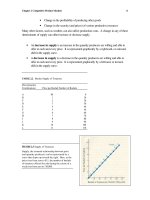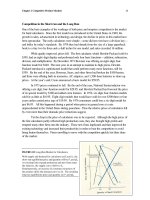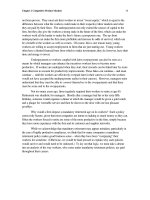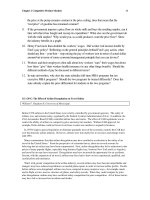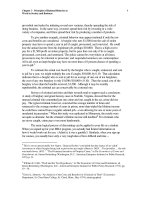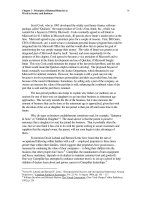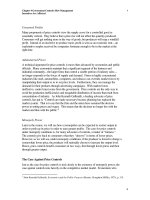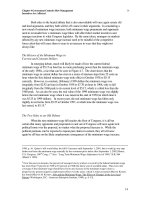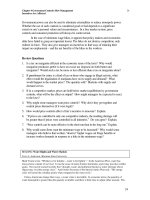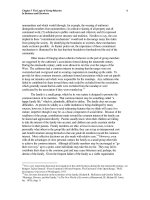Tài liệu Microeconomics for MBAs 21 ppt
Bạn đang xem bản rút gọn của tài liệu. Xem và tải ngay bản đầy đủ của tài liệu tại đây (41.56 KB, 10 trang )
Chapter 6. Reasons for Firm Incentives
19
have shown that people will be more cooperative with more equal shares of whatever it is that is
being divided (and women are more inclined to favor “equal shares” than men). People are
willing to extend favors in cooperative ventures in the knowledge that the favor will be returned.
They will work harder when they believe they are not underpaid. People are more likely to
cooperate with close family members and friends than far-removed strangers, and they will be
less likely to cooperate with others, whether close at hand or far removed, when the cost of
cooperating is high. They work harder, in other words, when they believe they are among
members of their relevant “in-group.” Even training can be more effective in raising worker
productivity when it is provided within in-groups, regardless of whether they come from
collectivistic or individualistic societies.
Why is it that people are inclined to cooperate more or less naturally? Wilson repeats a
favorite example of game theorists to explain why “cooperativeness” might be partially explained
as an outcome of natural selection. Consider two people in early times, Trog and Helga, who
are subject to attack by sabretooth tigers. The “game” they must play in the woods is a variant
of the prisoner’s dilemma game. If they both run, then the tiger will kill and eat the slowest
runner. If they both stand their ground -- and cooperate in their struggle – then perhaps they
can defeat the tiger. However, each has an incentive to run when the other stands his or her
ground, leaving the brave soul who stands firm to be eaten.
What do people do? What should they do? Better yet, what do we expect them to
do -- eventually? We suspect that different twosomes caught in the woods by sabretooth tigers
over the millenniums have tried a number of strategies. However, running is, over the long run, a
strategy for possible extinction, given that the tiger can pick off the runners one by one. We
should not be surprised that human society has come to be dominated by people who have a
“natural” tendency to cooperate or who have found ways to inculcate cooperation in their
members. Moreover, parents spend a lot of family resources trying to ensure that children see
the benefits of cooperation, and school teachers and coaches reinforce those values with an
emphasis on the benefits of sharing and doing what one is supposed to do or has agreed to do
vis a vis people beyond the reach of the family. Managers do much the same.
Those societies that have found ways of cooperating have prospered and survived.
Those that haven’t have languished or retrogressed into economic oblivion, leaving the current
generation with a disproportionate representation from groups that have been cooperative.
Those who didn’t cooperate long ago when confronted with attacks by sabretooth tigers were
eaten; those who did cooperate with greater frequency lived to propagate future generations.
What we are saying here is that human society is complex, driven by a variety of forces
-- based in both psychology and economics -- that vary in intensity with respect to one another
and that are at times conflicting. However, there are evolutionary reasons, if nothing else, to
expect that people who cooperate will be disproportionately represented in societies that
survive. Organizations can exploit -- and, given the forces of competition, must exploit --
people’s limited but inherent desire or tendency to work together, to be a part of something that
Chapter 6. Reasons for Firm Incentives
20
is bigger and better than they are. Organizations should be expected to try to reap the
synergetic consequences of their individual and collective efforts.
However, if that were the whole story -- if all that mattered were people’s tendencies to
cooperate -- then management would hardly be a discipline worthy of much professional
reflection. There would be little or no need or role for managers, other than that of cheerleader.
The problem is that firms are also beset with the very incentive problems that we have stressed.
The evolutionary process is far from perfect. Moreover, as evolutionary biologist Richard
Hawkins has argued, we are all beset with “selfish genes” intent on using “survival machines”
(living organisms such as human beings) to increase our chances (the genes’ individual chances,
not so much the species’ chances) of survival.
26
“Selfish genes” are willing to cooperate, if
that’s what is needed (or, rather, is what works); but the fundamental goal is survival. To the
extent that Hawkins is right, what he might be saying is, in essence, that we have to work very
hard to override basic, self-centered drives at the core of our being.
It may well be that two people can work together “naturally,” fully capturing their
synergetic potential. The same may be said of groups of three and four people, maybe ten or
even thirty. The point that emerges from the “logic of collective action” is that as the group size
-- team or firm -- gets progressively larger, the consequences of impaired incentives mount,
giving rise to the growing prospects that people will shirk or in other ways take advantage of the
fact that they and others cannot properly assess what they contribute to firm output.
As we have already studied, economists concerned with the economics of politics have
long recognized how the “logic of choice” within groups applies to politics. The infamous
“special interest” groups, which are relatively small and have long been the whipping boys of
commentators, tend to have political clout that is disproportionate to their numbers. Indeed,
special interest groups often get benefits from governments, with the high costs of their programs
diffused over a much larger number of a more politically latent group, the general population of
voters. Mancur Olson cites farmers for being the classic case of an interest group that
constitutes a minor fraction (less than three percent) of the population but that has persuaded
Congress to pass a variety of programs over the years that benefit farmers and their families and
impose higher prices on consumers and higher taxes on taxpayers.
27
Political economist James Buchanan points out that honor codes, which, when they
work, can be valuable to all students, tend to break down as universities grow in size. For that
matter, crime, which is a violation of the cooperative tendency of a community, if not a nation,
tends to rise disproportionately to the population. Buchanan’s explanation is that the probability
26
Richard Hawkins, The Selfish Gene (New York: Oxford University Press, 1989).
27
Mancur Olson, The Logic of Collective Action: Public Goods and the Theory of Groups (Cambridge, Mass.: Harvard
University Press, 1965).
Chapter 6. Reasons for Firm Incentives
21
of criminals being detected, arrested, and prosecuted falls with the growth in the populations of
cities.
28
James Wilson also stresses that experimental evidence shows that people in small towns
are, indeed, more helpful than people in larger cities, and the more densely packed the city
population, the less helpful people will be. Presumably, people in smaller cities believe that their
assistance is more detectable. People in larger cities are also less inclined to make eye contact
with passersby and to walk faster, presumably to reduce their chances of being assaulted by
people who are more likely to commit crimes.
29
In his survey of the literature on the contribution of individuals to team output, Gary
Miller reports that when people think that their contribution to group goals, for example, pulling
on a rope, cannot be measured, then individuals will reduce their effort.
30
When members of a
team pulling on a rope were blind folded and then told that others were pulling with them, the
individual members exerted 90 percent of their best individual effort when one other person was
supposed to be pulling. The effort fell to 85 percent when two to six other players were pulling.
The shirking that occurs in large groups is now so well documented that it has a name -- “social
loafing.”
A central point of this discussion is not that managers can never expect workers to
cooperate. We have conceded that they will – but only to a degree, given normal
circumstances. However, there are countervailing incentive forces, which, unless attention is
given to the details of firm organization, can undercut the power of people’s natural tendencies
to cooperate and achieve their synergetic potential.
What Firms Should Do
An important message of this chapter is that because people can’t have everything they want,
they will do what they can to get as much as they can. “Firms” are a means by which people
can get “more” of what they want than otherwise. Firms are expensive operations, by their
nature. Accordingly, people would not bother organizing themselves into “firms” if there were
not gains to be had by doing so. But therein lies a fundamental dilemma for managers, how can
managers ensure that the gains that could be had are actually realized and are shared in some
mutually agreed upon way by all of the “stakeholders” in the firm? The problem is especially
difficult when everyone associated with the firm – owners, managers, line workers, buyers, and
suppliers -- probably want to take a greater share of the gains than they are getting and
28
See James M. Buchanan, “Ethical Rules, Expected Values, and Large Numbers,” Ethics, vol. 76 (October
1965), pp. 1-13. From the strictly economic perspective, what is truly amazing in large cities is not how many
crimes are committed, but how many people respect the property and human rights of their fellow citizens, in
spite of the decreased incentives to do so.
29
Wilson, The Moral Sense, p. 49.
30
Gary J. Miller, Managerial Dilemmas: The Political Economy of Hierarchy, (New York: Cambridge
University Press, 1992), chap. 9.
Chapter 6. Reasons for Firm Incentives
22
contribute less in the way of work and investment than they are contributing. Managers have to
find ways of overcoming the stakeholders’ inclination to “give little but take a lot.” One of the
rolls of incentives is to overcome that inclination by tying how much people receive with what
they give to the firm.
One of the more important lessons business people learn is that efficiencies can be
realized from specialization and exchange. Anyone who attempted to produce even a small
fraction of what he or she consumed would be a very poor person indeed.
You may recall that the late economist Leonard Reed wrote a famous article (included
at the end of Chapter 1) in which he pointed out that no one person could make something even
as simple as a lead pencil.
31
It takes literally thousands of people specializing in such things as
the production of paint, graphite, wood products, metal, machine tools, and transportation to
manufacture a pencil and make it conveniently available to consumers. No one knows enough –
or can know enough – to do everything required in pencil production. Prosperity depends on
our ability to become very efficient in a specialized activity and then to exchange in the market
place the value we produce for a wide range of products that have been efficiently produced by
other specialists. Our ability to exchange in the market place not only allows us to produce
more value through specialization, it also allows us to obtain the greatest return for our
specialized effort by imposing the discipline of competition on those from whom we buy.
In this chapter, we extend our discussion of how transaction costs in markets can cause
firms to extend the scope and scale of their operations. We are concerned with a special form
of “opportunistic behavior” relating to the use of specialized plant and equipment that can cause
firms to make things themselves even though outside suppliers could produce those things more
efficiently.
Make or Buy Decisions
Much the same advantage from specialization and exchange applies to firms as well as
individuals. But that comment begs an important question: Exactly what should firms make
inside their organizations and what should they buy from some outside vendor? Business
commentators have a habit of coming up with rules that don’t add very much to the answer.
For example, one CEO deduced, “You should only do, in-house, what gives you a competitive
advantage.”
32
Okay, but why would anyone get a competitive advantage by doing anything
inside, given that such a move reduces, to one degree or another, the advantage of buying from
31
See Leonard Reed, “I Pencil,” The Freeman, December 1958: pp. 32-37.
32
Al Dunlap and Bob Andelman, Mean Business: How I Save Bad Companies and Make Good Companies
Great (New York: Times Books, 1996), p. 55.
Chapter 6. Reasons for Firm Incentives
23
the cheapest outside competitor? Answers have varied over time (although the one we intend
to stress relates to incentives).
At one time, the answer to the make-or-buy problem would have focused on
technological considerations: Firms often produce more than one product because of what
economists call “economies of scope,” a situation where the skills developed in the production
of one product lower the cost of producing other products.
33
But even firms with diverse
product lines are actually quite specialized in that they purchase most of the inputs they use in
the market rather than produce them in-house. General Motors, for example, does not produce
its own steel, tires, plastic, or carpeting. Instead, it is cheaper for General Motors, and the
other automobile manufacturers, to purchase these products from firms that specialize in them
and to concentrate on the assembly of automobiles.
34
Neither do restaurants typically, grow
their own vegetables, raise their own beef, catch their own fish, or produce their own
toothpicks.
Given the advantages of specialization in productive activities and buying most of the
needed inputs in the market place, a reasonable question is why firms do as much as they do?
Why don’t firms buy almost all the inputs they need, as they need them, from others and use
them to add value in very specialized ways? Instead of having employees in the typical sense,
for example, a firm could hire workers on an hourly or daily basis at a market-determined wage
reflecting their alternative value at the time. Instead of owning and maintaining a fleet of trucks,
a transport company could rent trucks paying only for the time they are in use. Loading and
unloading the trucks could be contracted out to firms that specialize in loading and unloading
trucks. The transport firm would specialize in actually transporting products. Similarly, the
paper work required for such things as internal control, payroll, and taxes could be contracted
out to those who specialize in providing these services.
Indeed, taken to the limit there would cease to be firms as we typically think of them.
Rather there would be only individual resource owners all operating as independent contractors,
with each buying (or renting) everything they need to add value in a very specialized way and
then, after the value is added, selling to another individual who adds more value until a good or
service is finally sold to the final consumer.
This extreme form of specialization and reliance on market exchange is clearly not what
we observe in the economy. There are limits to the efficiency to be realized from further
33
For example, a firm that has the equipment necessary to produce one type of electrical appliance may find
that this equipment can be fully utilized if also used to produce other types of electrical appliances.
34
Historically, automobile manufacturers did produce quite a lot of their parts in-house for reasons that will
be explained later in this chapter. But the trend has been to rely more on outside suppliers, with the lowest
cost manufacturers leading this trend. For example, Chrysler, the lowest-cost American producer, was
producing only 30 percent of its parts in-house in the mid 1990s, versus 50 percent for Ford (the second
lowest-cost American producer) and 70 percent for General Motors. Toyota produces only 25 percent of its
parts in-house. See John A. Byrne, “Has Outsourcing Gone Too Far?” Business Week, April 1, 1996, p. 27.
